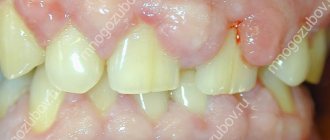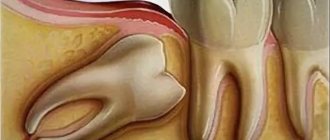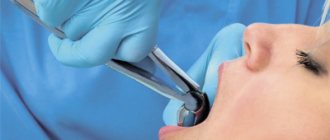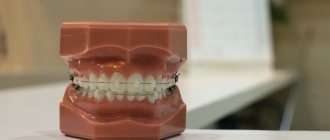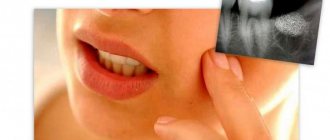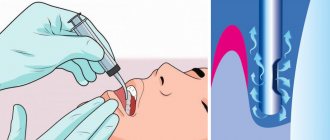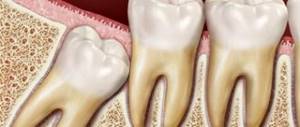Wisdom teeth, or “eights,” erupt at a late age – after 20 years. According to statistics, they are the ones who most often suffer from caries. And all because the teeth are “far away”, it is inconvenient to brush them, and so they begin to deteriorate.
Should I treat or remove a wisdom tooth due to caries? A pressing issue for patients. In 80% of cases, doctors advise immediately getting rid of carious “eights”. After all, filling them takes a long time, is painful and often does not give results.
Clinical picture
Caries of eights is often asymptomatic, especially in the early stages. But when a deep carious “hole” is formed, acute pain appears when exposed to cold, hot, or sweet food. The discomfort goes away immediately after the irritant is removed.
As a rule, conventional instrumental examination is used for diagnosis. When probing the cavity, sensitivity occurs at the enamel-dentin boundary. At the bottom of the “hole”, softened, dead brown dentin accumulates. Tapping on the enamel does not cause pain.
Wisdom tooth to be removed due to caries
When do you need to see a dentist urgently?
Contacting a dentist is required in the following cases.
- Pericoronitis
– the “hood” will be excised. - The figure eight puts pressure on neighboring teeth
- it needs to be removed. - Initial caries
– treatment will be carried out. - Medium, deep caries or rotten tooth
- a clear removal of the figure eight. - The wisdom tooth is loose
- a diagnosis of its condition will be carried out, according to the results of which the molar will be treated or removed. - Pulpitis
– if the root canals are passable, they will be filled.
This list should also include the above symptoms of pathological teething - pain when opening the mouth, swallowing, high temperature. If they appear, you should contact your dentist immediately, since this is a serious inflammatory process, the localization of which requires adequate treatment.
The reason for contacting a specialist may also be the “normal behavior” of the number eight. In this case, the doctor will simply make a small incision on the gum, thereby facilitating the eruption of the wisdom tooth. After a simple procedure, the process will be less painful, and the incision site will heal quickly, after pain for 2 to 4 days.
What to do if caries appears on the “eight”
Any type of caries must be treated, otherwise the infection will spread throughout the entire oral cavity, affecting healthy teeth. Therefore, the problem cannot be ignored, even if an unnecessary and invisible wisdom tooth is sick.
Contact your dentist promptly. Before visiting the clinic, rinse your mouth with antiseptic liquids: chlorhexidine, soda-saline solution or chamomile decoction at room temperature.
For severe pain, you can take an analgesic tablet - Analgin, Ketanov, Nurofen, etc.
Stages of treatment
- Drilling out carious tissues with a drill.
- Rinsing the cavity with an antiseptic solution, such as hydrogen peroxide.
- Applying an insulating and therapeutic pad to the bottom.
- Layer-by-layer filling of the cavity with a photopolymer composite.
- Restoration of the anatomical shape and masticatory cusps on the surface of the molar.
The procedure lasts about 30 minutes and is performed under local anesthesia.
Restoration of wisdom teeth
How to understand that a wisdom tooth is cutting?
It's not difficult to understand. Normally, this process is accompanied by discomfort, engorgement and slight swelling of the gums in the place where the tooth is cut. At the moment of eruption, increased salivation, a feeling of fullness and tolerable pain will be observed. They can intensify during eating and hygiene procedures. Visually and by touching the tongue, you can see and feel the protruding tubercles of the figure eight.
In the pathological course of the process, the following symptoms may join the above-described symptoms.
- Redness and swelling of the gums indicate inflammation of the “hood”.
- It hurts to open your mouth - the inflammation process is progressing and has spread to the masticatory muscle.
- It hurts to swallow - a symptom indicates the presence of purulent inflammation of the soft tissues closer to the tongue.
- High temperature - the inflammatory process progresses.
- The third molar, the adjacent tooth and gums are very painful - most likely, the figure eight is growing in the wrong direction.
Additionally, symptoms may occur depending on the location of the wisdom tooth.
- The upper eights can erupt towards the cheek and injure its mucous membrane, causing pain.
- The lower molars often form a “hood” and grow with an inclination towards the seven, forming a gap. It is difficult to clean with a brush. Over time, a stable plaque and tartar form in it, which leads to the development of caries.
You should not trust various kinds of myths, they say, the appearance of a wisdom tooth is always excruciatingly painful, very problematic and you just need to endure it. It is not true! Normally, the process does not cause excruciating pain and passes with tolerable discomfort. On the contrary, problem eights hurt a lot, provoking the development of inflammation and complications. Therefore, it is better not to delay visiting the dentist.
Treat or remove
Treating a wisdom tooth is an extremely difficult task due to its inaccessibility. Some instruments do not even reach the carious lesion. In addition, the patient should sit with his mouth wide open at all times. Therefore, dentists suggest immediately removing the problematic tooth.
Why do wisdom teeth need to be removed in most cases?
- Firstly, the third molar has completely lost its function in the process of evolution and is now considered a vestige. It's not at all a shame to get rid of it.
- Secondly, it is almost impossible to clean a carious lesion efficiently. There is a high risk of developing secondary caries. Is it worth spending money and time on treatment?
The decision is made by the doctor on an individual basis; first you need to take an x-ray and conduct an instrumental examination.
3 indications for removal
- The advanced stage is when the wisdom tooth has crumbled and cannot be restored.
- Absence of an antagonist tooth. The antagonist is the closing molar, which is located on the opposite jaw. If it is missing, the wisdom tooth decays faster due to lack of chewing load.
- Retention or dystopia - if the tooth grows horizontally, at an angle, or remains in a semi-erupted state, then this is a reason for removal.
If, due to anatomical features, a person cannot open his mouth wide or has a pronounced gag reflex, it is also not possible to carry out full therapy.
Of course, if the wisdom tooth has grown correctly, in its place, then it can be treated if desired. It is recommended to leave the “eight” if it is needed to install a prosthesis. It often happens that a patient is missing the seventh and sixth teeth in a row, so the third molar becomes a support for fixing a bridge, clasp prosthesis or other orthopedic structure.
What to do if your wisdom tooth gets sick during pregnancy?
Pregnancy is a contraindication to removal due to the high risk of complications. In this case, the doctor decides: to treat wisdom tooth caries or remove the “eight” later (after the birth of the child). As a rule, it is better to carry out therapy, because any infection in the body, even caries, is harmful to health. And if there is a deep carious “hole”, it is necessary to put a filling.
Painless wisdom tooth treatment at the Beryozka dental clinic
Wisdom teeth (or as doctors also call them - “eights”, third molars) often cause people a lot of trouble.
Moreover, according to medical expert statistics, it is they who are at risk of carious lesions more than any other area on the jaw. The causes of caries on the “eight” are no different from the causes of the disease in other teeth - poor heredity, neglect of hygiene and an excessive amount of carbohydrates in the daily diet. A specific factor that increases the risk of developing caries on the surface of a wisdom tooth is its location. Third molars that erupt in the gums, as a rule, not completely, are “embedded” in the jaw at an angle, which contributes to the accumulation of food debris in the tissue “hood.” It is difficult to clean the hidden corners of distant areas, and bacteria developing due to food debris contribute to active carious lesions of the “eight”.
Causes
“Eight” is the outermost tooth in the row; it is difficult to reach it, even with a toothbrush. Therefore, the quality of daily hygiene care deteriorates. Bacterial plaque accumulates on the enamel, containing a large number of cariogenic microbes - Streptococcus mutans.
Bacteria destroy the enamel, starting the carious process. This is why third molars deteriorate more often than other teeth.
There are cases when a wisdom tooth has partially erupted. The gums cover part of the figure eight, which prevents normal cleaning. Food particles and plaque get under the formed gingival hood, which contributes to the process of suppuration. Therefore, even an unerupted tooth is often already sick.
Complications of wisdom tooth caries
Symptoms of wisdom tooth caries
The main danger of the disease is that it is asymptomatic for a long time. And if the patient ignores regular preventive examinations at the dentist, he will learn about the problem at a deeper stage. For example, cervical caries of a wisdom tooth is often discovered only when the patient begins to suffer from sudden pain.
At first, a dark spot appears on the enamel, but it is difficult to see, because the tooth is located far away and at an angle. There is no pain because the enamel is devoid of nerve endings.
As the disease progresses, it continues to destroy the enamel and reaches the dentin. Here the first symptoms begin to appear - bad breath, and sometimes short-term pain under the influence of mechanical, temperature and chemical stimuli. You need to remember: if your wisdom tooth hurts, caries is most likely the cause.
Dentin is a porous tissue, so at the middle stage the disease begins to progress very quickly: demineralization of the tooth occurs and necrotic changes begin. Deep caries of a wisdom tooth is characterized by damage to hard tissues, which is why the tooth reacts strongly to hot and cold, sour and sweet. A prolonged aching pain occurs, the coronal part is severely destroyed.
Complication of caries
With prolonged caries, the infection penetrates into the deep tissues and affects the dental nerve (pulp). An inflammatory process begins inside the tooth - pulpitis, which is accompanied by spontaneous aching pain. In this case, it is necessary to fill the root canals; this is a difficult task, given that the roots of the “eights” are usually very curved and have an irregular shape.
If pulpitis is not cured, sooner or later more serious forms of complications will arise - periodontitis or granuloma. Therefore, do not delay your visit to the dentist; treat caries in a timely manner.
How long will the cutting and toothache last?
The process of cutting through the figure eight is long and highly individual. In some patients it “appears” in 3–4 months, in others it may take 1–2 years, and in others it remains incompletely erupted. Quite often, a wave-like “appearance” of the third molar is observed - either it is intensively cut, or it freezes.
As for severe pain, as a rule, it is present only at the beginning of the process - at the stage when the figure eight cuts through the dense gum tissue. And again, this moment can happen quite quickly or drag on for a long time.
When the first signs of figure eight eruption appear, it is better not to postpone a visit to the doctor. Even if the process does not cause severe pain or discomfort, it is better to show it to the dentist. An experienced specialist will examine the condition of the third molar and provide assistance that will facilitate the process of “the birth of the tooth.”
How to relieve pain if a wisdom tooth grows and your gums hurt.
The growth of wisdom teeth is not painless for every person, so most people need to know what to do in case of inflammation of the gums around the wisdom tooth and acute aching pain.
If there is inflammation, pain, or if the cheek is swollen near the wisdom tooth, you should contact your dentist, he will conduct an examination and take the necessary measures to eliminate symptomatic manifestations.
If the pain begins in the evening or it is not possible to quickly contact a specialized specialist, doctors recommend several ways to reduce pain:
- Rinse the growth with calendula tincture after eating - this will reduce the intensity of the inflammatory process and also reduce pain;
- Rinse your mouth with a solution of baking soda in water, at the rate of 1 teaspoon of soda per 1 glass of water (200 grams) - soda calms inflammation and also reduces pain;
- To rinse the mouth, you can use decoctions of chamomile, oak bark, chicory root, as well as sage tincture and propolis;
- Anti-inflammatory, painkillers and antibacterial drugs - use according to the instructions. They help reduce pain, reduce swelling, and also eliminate the negative bacterial influence at the site of tooth eruption.
In case of acute unbearable pain, as well as the absence of the above remedies, you can use cold water to reduce pain: take a glass of cool water, put a small amount in your mouth and hold it in the area where the wisdom tooth is erupting - this can quickly reduce the level of pain. However, this method has one negative feature - the pain intensifies almost immediately after stopping holding cool water at the site of gum inflammation, for example, near the hood of a wisdom tooth.
When should a tooth be removed?
Direct indications for wisdom tooth removal are the following pathologies and conditions.
- There is no place in the dentition for a number eight.
- Dystopic tooth (molar occupies an anatomically incorrect position).
- The appearance of wisdom teeth threatens the molars in front.
- Severe forms of caries that destroy the tooth.
- The third degree of mobility of the figure eight.
- Upcoming installation of braces.
If removal is not carried out, the development of complications is inevitable. The number eight will destroy adjacent teeth and provoke the development of pulpitis, periodontitis, and extensive caries. Eventually it will fall out on its own, but at too great a cost to the patient.
There is no need to be afraid of wisdom tooth removal. Depending on the complexity of the problem, third molar extraction will last from 20 minutes to 2 hours. The operation is performed using local anesthesia or sedation, which ensures that the procedure is painless.
Myth three: a tooth should not hurt after filling
Many people believe that after filling the tooth should not hurt. In reality, this does not always happen. “In 2/3 of cases this is exactly the case, but there are very deep damages to the tooth, in which the filling is located close to the pulp chamber. In this case, the material, when pressed on during chewing, transfers the load to the bottom of the cavity, which is already thin. Under this load, the bottom cannot adequately redistribute the resulting pressure along the dentin of the tooth, and part of it goes to the pulp. In this case, there may be a short-term pain sensation that goes away immediately. This is within normal limits,” says Ilya Antonov.
The doctor, as a rule, explains to the patient that such sensitivity will pass over time, as the dental tissue adapts to new conditions, but the tooth needs time for this, the dentist says. Therefore, under no circumstances should you stop chewing on it, but you should not overdo it. Otherwise, there will be trauma to the pulp from excessive pressure and the tooth will have to be depulped, the doctor emphasizes.
Why clean your tongue? 5 effective ways of oral hygiene Read more
Myth five: wisdom teeth cannot be filled
For many people, wisdom teeth are an unpleasant defect; they can only be removed. That’s why people rarely decide to get a filling. But in reality, it is quite possible to put fillings on wisdom teeth. “They even do a filling, there is only one nuance with it: it must be normally located in the oral cavity, that is, normal access to it must be ensured. These are, as a rule, the lower teeth and the upper teeth in the case when the patient can open his mouth wide and the doctor has the opportunity to work with the tip and instruments without strong restrictions on the location,” says Ilya Antonov.
Myth six: after filling, do not eat for 2 hours
The recommendation to limit food intake after a filling procedure is still stable. Moreover, people often give it to themselves. “Before, the doctor put a filling and said that you need to not eat for 2 hours. Now this limitation is only due to the fact that we use anesthesia during treatment. After this, the patient does not feel part of his cheek and lip. By starting to chew in this state, the patient runs the risk of biting himself. That’s why I always say that you can eat as soon as the anesthesia wears off,” says Ilya Antonov.
The value of x-ray diagnostics when removing wisdom teeth
No qualified doctor will remove wisdom teeth “blindly”. You cannot rely on external indicators. A clear assessment of the condition of the root system and the development of the tooth is necessary in order to eliminate complications that could arise after the operation. An x-ray must be taken to assess the feasibility of removing a particular wisdom tooth.
X-ray examination provides an informative picture that allows you to see:
- the presence of curved roots;
- number of root shoots;
- structural features.
Based on the results of X-ray diagnostics, the doctor will be able to draw up a surgical plan and eliminate errors in the form of bone fragments remaining in the gum.

